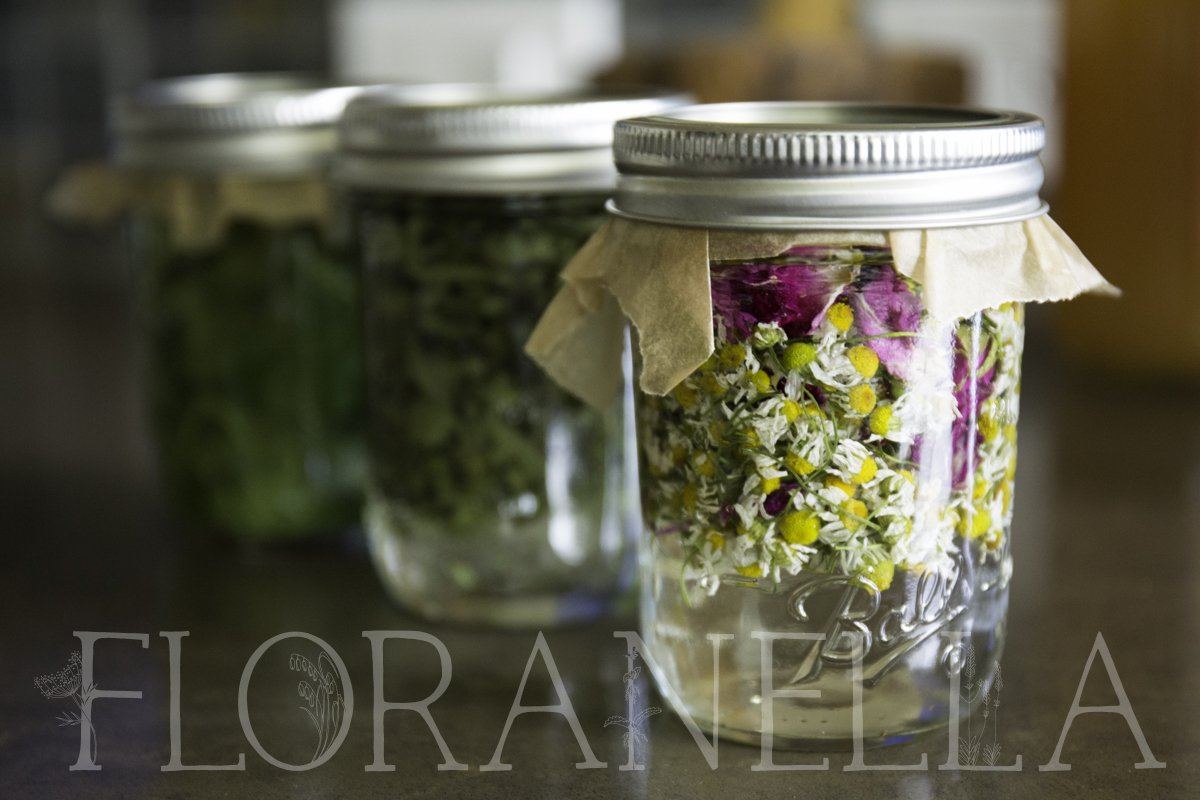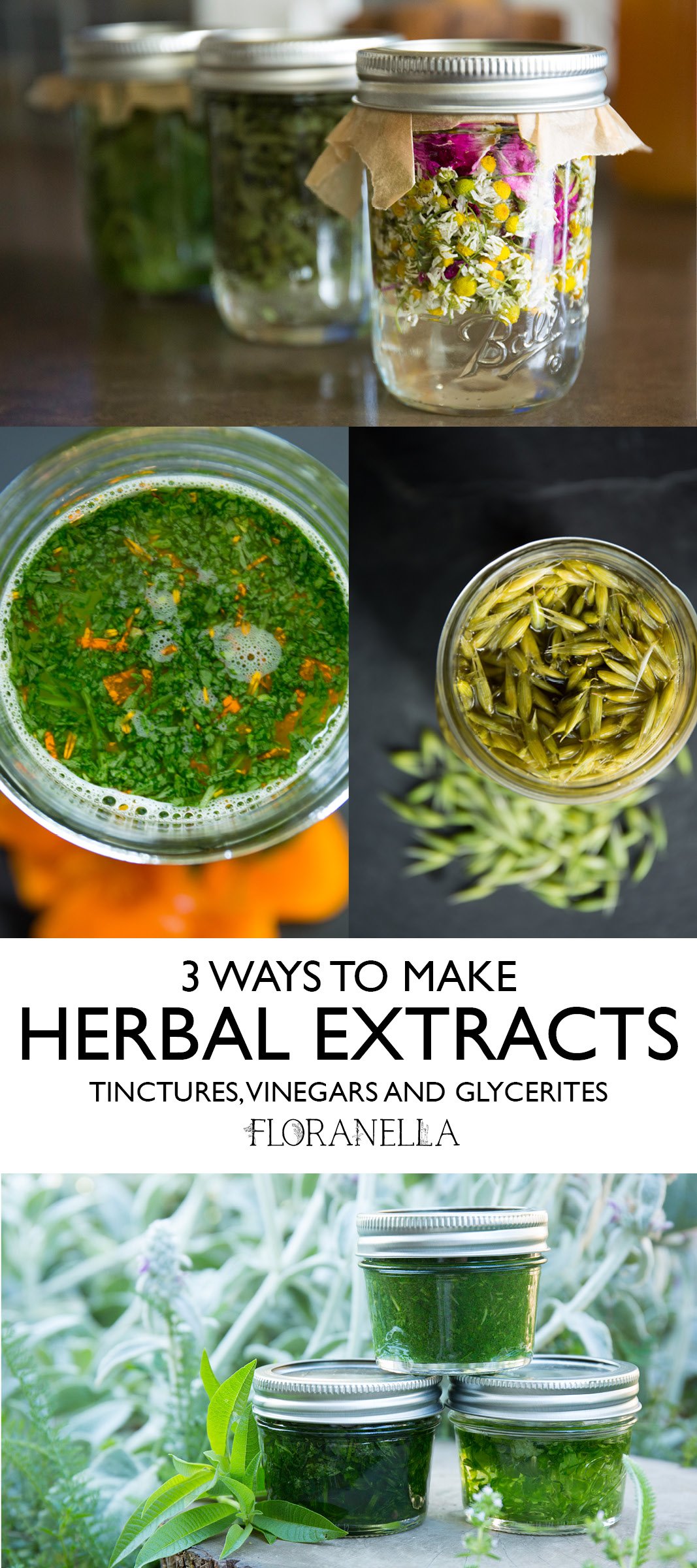How to Make Herbal Tinctures (+ Alcohol-Free Extracts)
Before I started working with herbs on a regular basis, I was always intrigued by the tincture aisle at our local health food store. I remember walking down it one day on my way to the probiotics section and thinking, “Wow! Look at all of them!” This particular store literally had a full aisle of tinctures from all different brands. I used to stand there and look through all of the different options and wonder what they were used for while the cold items in my shopping cart slowly approached room temperature and my husband waited patiently for me to finish up so we could get home to cook dinner. I still sometimes stop and just browse through the tincture section at the local co-op. They still fascinate me!
Tinctures can be made in several different ways. The easiest of these is known as the folk method or the simpler’s method, which requires only your plant material and alcohol that is readily commercially available. You can also make alcohol-free herbal extracts if you wish to avoid working with alcohol-based tinctures.
Alcohol-Based Tinctures
Alcohol-based tinctures are liquid herbal extracts made with high quality alcohol, usually at least 80-proof (40% alcohol content), and fresh or dried plant material. They are the most popular kind of herbal extract because the alcohol is so effective at extracting most of the medicinal compounds found in our herbs and because alcohol-based tinctures are incredibly shelf stable. They can last for many years without losing their potency, which makes them one of the most sustainable and effective ways to preserve herbs long-term, especially if the herb is scarce or slow-growing. Alcohol-based tinctures are also easy and convenient for people to take on the go, on busy days, or when they don’t have access to the fresh herb because it’s out of season or isn’t grown locally.
To make an alcohol-based tincture using the simpler's method, you could use either fresh or dried plant material. Some herbs are better tinctured fresh whilst others are better tinctured dried. (As you get to know the individual herbs and their chemical constituents better, you will learn how to tell whether the herb should be tinctured fresh or dried.) The most popular menstruums are vodka and brandy, but you could use just about anything as long as it's at least 80-proof alcohol.
Fill a clean and dry glass container about half to 2/3 of the way with your finely chopped fresh or dried herb and pour alcohol over the plant material until it is covered by at least an inch of liquid. Use a chop stick or butter knife to settle bubbles and make sure all of the plant material is making content with the alcohol.
Place a sheet of wax paper or waxed linen between the lid of your jar and the jar, then seal the lid. Store the tincture in a cool, dark place away from light and heat and allow the plant material to macerate in the alcohol for 4-6 weeks. You can shake it now and then when you open the cupboard if you like. After 4-6 weeks, strain the herb out of the alcohol using a cheesecloth or muslin-lined fine mesh sieve. Squeeze the cheesecloth tight at the end (or use a press, if you have one) to make sure you've got every last drop that you can, then pour your finished tincture into a clean, dry bottle. I like to use amber glass bottles for my tinctures. Add a label that includes the kind of herb you used, where you sourced it and the year you harvested it if you grew it yourself (or the year you bought it), the kind of alcohol you used, and the date you strained it. Store the finished tincture away from light and heat.
For home use, the simpler’s method of tincture-making is completely efficient, but for commercial production, a more standardized process is used to ensure consistency between batches. Specific ratios of plant material to alcohol are used and the kind of alcohol used is usually a higher proof alcohol that is diluted according to the specific plant’s requirements.
Vinegar-Based Extracts
Vinegar-based extracts are made much the same way alcohol-based tinctures are, but the menstruum used to make them is raw apple cider vinegar instead of alcohol. Fill your sanitized jar ½ - 2/3 with your herb(s) and then cover with raw apple cider vinegar and allow to macerate for 4 to 6 weeks before straining. I prefer to store vinegar tinctures in the fridge, both while they are macerating and after they have been strained, to prolong their shelf life, especially if I am using fresh plant material in the extract.
Vinegar extracts are especially effective for extracting minerals from mineral-rich plants like nettles and milky oats, so if you’re hoping to achieve a mineral-rich extract, you may want to go for a vinegar-based preparation rather than an alcohol-based one. The two different menstruums extract different constituents from the plant and when you’re wanting the minerals, vinegar is usually the way to go.
People who do not take alcohol for religious reasons or because of a past problem with alcohol, people with impaired liver function, and others who just prefer not to use alcohol-based tinctures can use a vinegar extract instead of a tincture. Vinegar extracts are not always as strong or effective, depending on the solubility of the constituents in the herbs you choose.
Vinegar extracts are also kid friendly if you add some honey to the preparation, and are quite versatile. You can use them in salad dressings and shrubs and they can be taken on their own or in combination with other ingredients as drinking vinegars. They can be a fun way to experiment with using food therapeutically by incorporating your herbs into your daily routine in a tasty way.
Glycerin-Based Extracts (Glycerites)
Glycerin can also be used to extract some of the constituents from your herbs. Prepare the glycerin extract, also called a glycerite, the same way you would either of the other two kinds of tinctures but with organic, food-grade glycerin as your solvent. The resulting extract is a glycerin-sweet preparation that is especially friendly for children who may not want to take a vinegar extract.
I rarely make glycerites because I'm not a fan of glycerin (it's highly processed), but it is definitely an option that is well-suited in some cases. I know many herbal clinics use glycerites regularly because their sweetness makes it easier for people to take their herbal remedies and because they are an easy way to deliver herbs to someone who doesn't wish to use an alcohol-based tincture.
Glycerites extract water-soluble constituents best.
Would you like to learn more about herbal / aromatic formulation? Consider joining me in our Herbal Aromatherapy Certification Program™. In it, we study more than 100 aromatic herbs, learn how to formulate safe and effective remedies, and study herbalism and aromatherapy from the garden to the still to the apothecary. I hope to see you in class!
About the Author
Hi there, I’m Erin! I am the main instructor here at Floranella. I am a clinical herbalist, aromatherapist, artisan distiller and organic gardener based in the Pacific Northwest. Here at Floranella, I teach people how to work with plants safely and effectively from the garden to the apothecary. Thanks for being here! I’m glad you stopped by.





